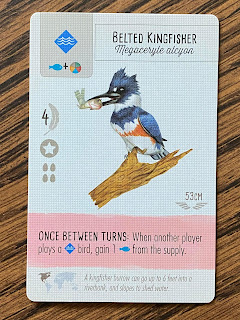While on a walk this past weekend at Meadowlark Gardens, I heard an interesting trill or rattle sound. I looked up and felt awe-struck by a gorgeous Belted Kingfisher flying over the pond and up into a tree, right next to us.
Photo: Mick Thompson (link)
While there are four species of Kingfisher in North America, the Belted Kingfisher, Megaceryle alcyon is the only one that is seen in Virginia - so this bird is easy to identify even for the most beginner birder. However, it is not as common as some birds, so you have to be fairly lucky to see it at all. This past Sunday was my first time seeing one up close, and it is a striking bird, both in color, call and behavior.
Photo: Andy Morffew (link)
Kingfishers, like most birds, are sexually dimorphic, meaning the males and females do not look alike. However, the Belted Kingfisher is unusual in that the female of the species is more colorful - they have the orange belt, while the males do not. According to All About Birds, Kingfishers are very territorial birds, and some scientists hypothesize that the orange band allows males to differentiate females from rivals, but more studies are needed.
Photo: marneejill (link)
This bird is often seen around wetlands and water bodies, where it hunts fish by plunging headfirst into the water and grabbing fish with its beak. According to Audubon Society, this species:
"...typically feeds on small fish, usually those less than 4-5" long. Also eats crayfish, frogs, tadpoles, aquatic insects. Occasionally takes prey away from water, including small mammals, young birds, lizards. Reported to eat berries at times."
This neat video below shows how easily a Belted Kingfisher can pluck fish out of the water.
This species has an interesting nesting approach - they actually dig tunnels, three to six feet long (!) into the the dirt of steep, sandy banks, with the nest chamber at the end. Both male and female help dig the nest tunnel. Amazing! You can read more about this nesting behavior here. Unfortunately, this species may be declining due to habitat loss and nest disturbance during breeding season. You can help this species by supporting organizations like Audubon that work on conservation and protection of these amazing animals. I recommend you join your local chapter and go out on a bird walk or attend a free Audubon Afternoon lecture.
My local chapter, Audubon Society of Northern Virginia, has some great resources on their website:
- Videos of past online events
- This handy, printable bird checklist for Northern Virginia
- The fantastic Audubon at Home program for a free home-consult on designing your native plant landscaping (native plants are the best bird feeders)
- Free upcoming webinar (Dec 16) to prepare for the Christmas Bird Count
Some other cool resources on birding:
- Birdability, making birding accessible to all
- Northern Virginia Birding Club
- This podcast featuring Matt Felperin's recommendations on great spots and good binoculars (I bought mine based on his suggestion)
- Wingspan, a beautiful and scientifically accurate strategy game about birds. Below is the Belted Kingfisher card from my set.
Happy birding everyone!
Sources:




No comments:
Post a Comment